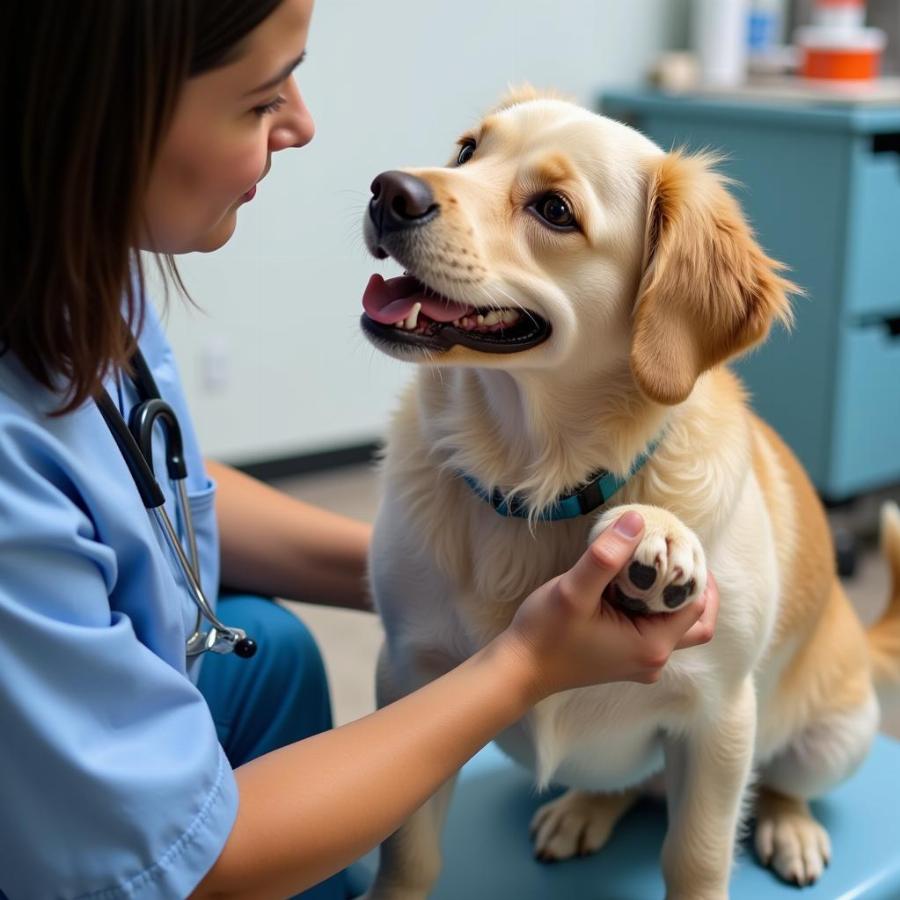The term “Grinch feet dogs” might sound amusing at first, conjuring images of our favorite green holiday grump. However, it’s actually a colloquialism used to describe a specific foot condition found in dogs. While not an official veterinary term, it’s gaining traction among dog owners and online communities. This article delves into the phenomenon of “Grinch feet dogs,” explaining what it means, potential causes, and most importantly, what you can do to help your furry friend if they exhibit this characteristic.
Deciphering “Grinch Feet”
“Grinch feet,” in simple terms, refers to a dog’s paws where the toes curl inwards, resembling the curled, almost mitten-like feet of Dr. Seuss’s Grinch. While it might seem purely aesthetic, this inward curling can sometimes be an indicator of an underlying health issue or a breed-specific trait.
Possible Causes of Inward Curling Toes in Dogs
There are several reasons why your dog might have “Grinch feet”:
- Genetics: Some breeds are naturally prone to having curled toes. This is often a desired trait in show dogs, contributing to their unique appearance. Breeds like the English Bulldog, French Bulldog, and Boston Terrier are known for their naturally curled toes.
- Improper Nail Trimming: If a dog’s nails are allowed to grow excessively long, it can force the toes to splay outwards. Over time, this might cause the toes to compensate by curling inwards.
- Injury: Trauma to the paw, like a fracture or sprain, can lead to changes in the foot’s structure, potentially causing the toes to curl.
- Neurological Conditions: In rare cases, inward curling toes might be a symptom of a neurological problem affecting the nerves that control the paw muscles.
When to Worry: Identifying Potential Problems
While “Grinch feet” can be a harmless quirk, it’s important to differentiate between a breed characteristic and a potential health concern. Here are some signs that your dog’s curled toes might warrant a visit to the veterinarian:
- Sudden Onset: If your dog’s toes suddenly start curling inwards and this wasn’t a pre-existing condition, it’s crucial to seek veterinary attention immediately.
- Lameness or Pain: Any signs of limping, favoring the paw, or vocalizing discomfort should never be ignored.
- Swelling or Redness: Inflammation in the paw, especially when accompanied by heat or redness, could signal an injury or infection.
- Difficulty Walking: If your dog’s curled toes are affecting their gait or balance, it’s important to consult with a veterinarian.
Caring for Your “Grinch Feet” Dog
Proper care for a dog with “Grinch feet” largely depends on the underlying cause.
- Regular Veterinary Checkups: Routine visits to the veterinarian are essential to monitor your dog’s foot health and catch any potential issues early on.
- Proper Nail Trimming: Maintaining your dog’s nails at an appropriate length is crucial. If you’re unsure how to trim your dog’s nails safely, consult your veterinarian or a professional groomer.
- Supportive Footwear: If your dog’s curled toes are causing discomfort or difficulty walking, your veterinarian might recommend supportive footwear or dog boots.
- Managing Underlying Conditions: In cases where “Grinch feet” are a symptom of an underlying health problem, addressing the primary condition is paramount.
 Veterinarian Carefully Examining a Dog's Paw
Veterinarian Carefully Examining a Dog's Paw
Don’t Let the Grinch Steal Your Dog’s Comfort
While “Grinch feet” can be a charming peculiarity, it’s vital to be aware of the potential implications for your dog’s well-being. By staying vigilant, scheduling regular veterinary checkups, and providing appropriate care, you can ensure your furry friend’s feet stay healthy and happy, whether they’re naturally curled or perfectly straight.
Frequently Asked Questions About “Grinch Feet” in Dogs
Q: Are “Grinch feet” painful for dogs?
A: Not necessarily. If the curling is a breed trait and doesn’t hinder their movement, it’s unlikely to cause pain. However, if it’s due to injury or other health issues, it can be quite painful.
Q: Can “Grinch feet” be corrected?
A: It depends on the cause. In some cases, if addressed early, corrective measures like splinting or physical therapy might be possible. However, if it’s a genetic trait or the result of long-term changes, it might not be fully correctable.
Q: Do dogs with “Grinch feet” need special shoes?
A: Not all dogs with “Grinch feet” require shoes. However, if your dog’s toes are causing them to slip, have difficulty walking, or are prone to injury, your veterinarian might recommend supportive footwear.
Q: What should I do if I notice my dog’s toes suddenly curling inwards?
A: Schedule an appointment with your veterinarian immediately. Sudden changes in a dog’s paw structure should always be evaluated by a professional.
Looking for More Information?
- [Link to an article about dog paw care on Beaut Dogs]
- [Link to an article about common dog foot problems on Beaut Dogs]
Beaut Dogs: Your Trusted Source for Dog Care Information
Beaut Dogs is your one-stop resource for everything related to dog care. We provide reliable, insightful, and expert-backed information to help you understand and care for your canine companion. For personalized advice or to discuss your dog’s specific needs, please reach out to our team at [email protected].